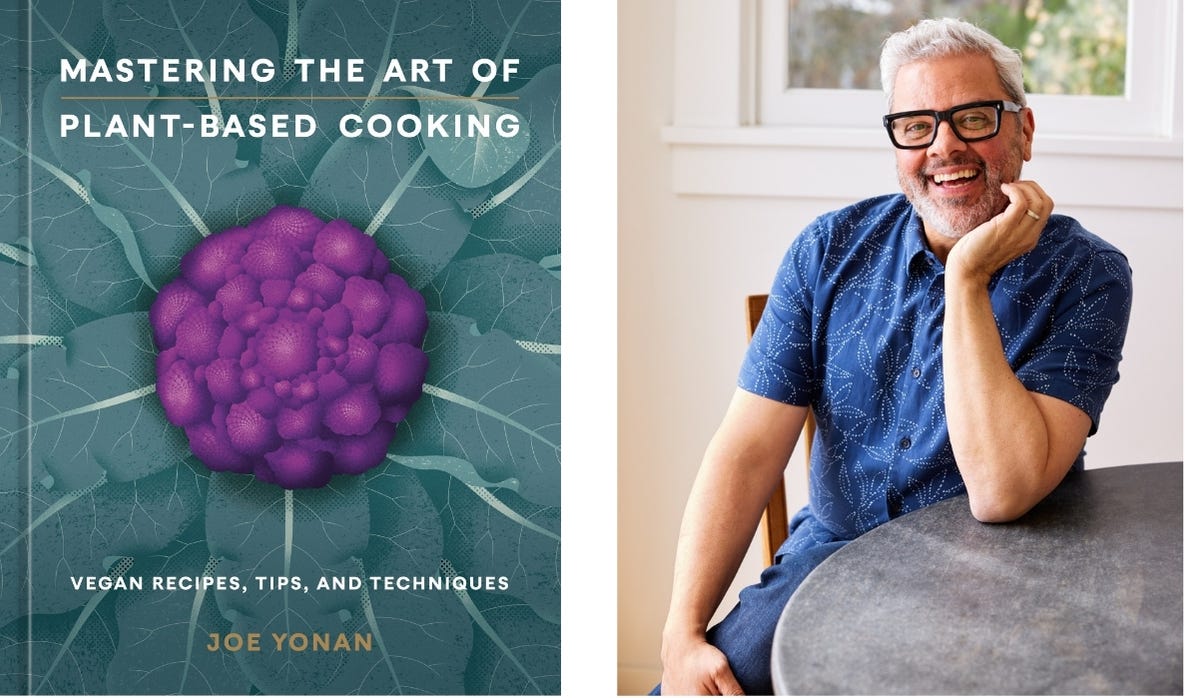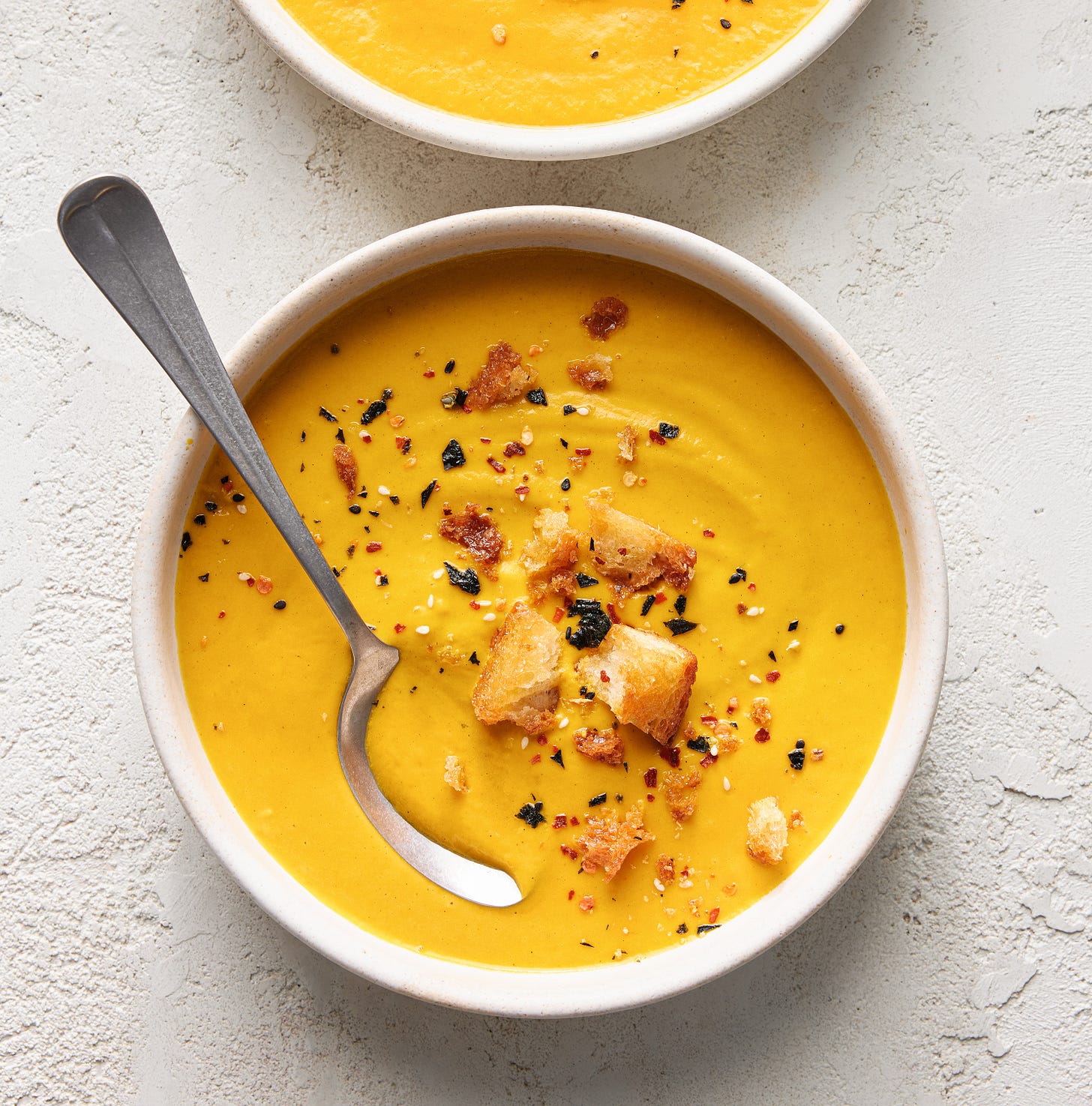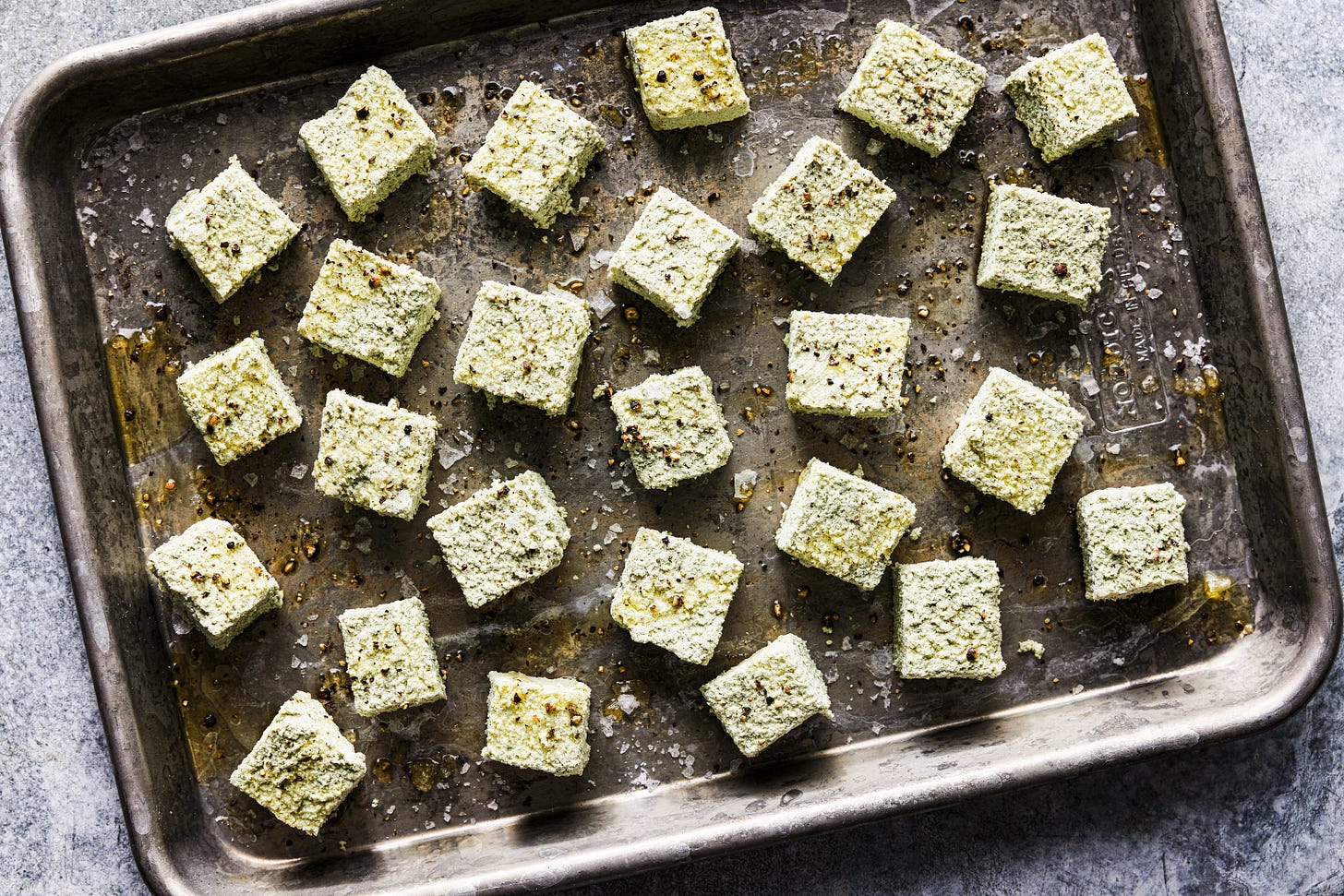Learning plant-based cooking with Joe Yonan
For the cookbook author and food editor of The Washington Post, gaining skills in the kitchen is a lifelong process.
“One of the things that I loved the most about that title,” says Joe Yonan, Food and Dining editor of The Washington Post and author (most recently) of Mastering the Art of Plant-Based Cooking, “and this was part of why Judith Jones chose chose it for Julia Child’s first book, is the -ing, you know it’s Mastering, and that was very purposeful on her part, and I really liked it too, and the idea is: This is an ongoing process…You’re going to be learning about this, like everything, for the rest of your life.”
Joe’s massive new book, created in collaboration with an all-star group of recipe developers, meets you anywhere you are in that process. It’s at once a vast resource of globally-inspired recipes and a technique course for cooks at any level of experience who want to dial up the flavor of dinner tonight—and gain new skills cooking (and baking!) without meat, without dairy, and without eggs or other animal products.
It’s the kind of book I’d be excited to give to a recent grad who is just beginning to build a cooking routine—but longtime home cooks who are looking for ways to eat more vegetables will find so much to love here, too.
It was such a delight to talk with Joe about the book—and a few of the cookbooks in his personal collection that he’s loved and leaned on for a long time. (You’ll find the links below so you can add these volumes to your collection; book links are affiliate links, which means I may make a small commission on any purchase.)
While Joe shared lots of recipe recommendations, recording this episode also reminded me how nice it is to chat with great cooks about what they’ve been cooking off the cuff. Joe got me excited about roasting nutty pumpkin seed tofu (you can get the full recipe below) and turning one big pot of beans into a whole series of improvisational (and varied!) weeknight meals. (Trust me, this episode is worth listening to for the bean ideas alone.)
We talked about how to take the pressure off your dinner routine, how Joe has seen cooking in the US change over the course of his multi-decade career at the Washington Post, and how the many threads of Mastering the Art of Plant Based Cooking came together. I hope you enjoy listening in.
Please subscribe/follow the podcast so you don’t miss the next episode!
If you’re reading this in your inbox, you may need to click “view entire message” (located at the bottom of the email) to see the whole thing!
Joe’s frequent repeat recipes
Nearly Any Vegetable Coconut Soup (scroll down for the recipe!)
Vegan Baked Stuffed Shells (Reprinted from Mastering the Art of Plant-Based Cooking in The Washington Post)
Deb Perelman’s Pizza Beans (Smitten Kitchen) and Minimalist Baker’s vegan version
Assyrian-Style Vegan Meat and Rice Balls (Washington Post)
Two of Joe’s cookbook favorites
The New Spanish Table by Anya von Bremzen
Giuliano Hazan’s Thirty Minute Pasta: 100 Quick and Easy Recipes
A few more links you might be looking for after listening:
Yesterday’s Soup Just Became Today’s Pasta Sauce (Epicurious)
Burlap and Barrel’s Crushed Red Peppers (Razza pizzeria collab)
Nearly-Any-Vegetable Coconut Soup
Reprinted with permission from Mastering the Art of Plant-Based Cooking by Joe Yonan, copyright © 2024. Published by Ten Speed Press, a division of Penguin Random House, LLC.
For this formula, food writer and editor Sarah Jampel was inspired by her friend Caroline Lange, who is adept at turning a can of coconut milk and whatever vegetables are in her kitchen into an I-can’t-believe- you-just-made-this soup. Three variation examples follow, but as long as you use lots of alliums and other flavor-bringers—herbs, chiles, ginger, spice—you’re on your way to something delicious. Use your judgment: If you’re making a carrot soup whose color you want to preserve, for instance, you might go lighter on the soft green herbs. Once you get the hang of the method, add what calls to you: lemongrass, curry paste, soy sauce, miso—or any of the spice blends, salsas, and other condiments from the Building Blocks chapter of Mastering the Art of Plant-Based Cooking.
Makes 3 or 4 servings
Time: Weekday
Storage: Refrigerate, preferably without toppings, for up to 5 days and freeze for up to 6 months.
2 tablespoons oil (coconut, olive, vegetable, or avocado)
8 to 12 ounces (225g to 340g) alliums (scallions, leeks, onions), roughly chopped
2 to 6 garlic cloves, roughly chopped
1⁄2- to 1 1⁄2-inch (1.3cm to 4cm) piece fresh ginger, peeled and sliced (optional)
1 hot chile (serrano, jalapeño, or habanero), sliced (optional)
Fine sea salt
Up to 1 tablespoon ground or whole spices (red pepper flakes, whole dried chiles, coriander, cumin, fennel seeds, garam masala, smoked paprika, turmeric)
Up to 1 tablespoon chopped woody herbs (thyme, rosemary, sage)
1 to 2 pounds (450g to 910g) fresh or frozen vegetables (spinach or other greens, peas, butternut/kabocha squash, carrots, zucchini/ summer squash, canned tomatoes, sweet potatoes, corn, mushrooms), peeled and chopped if necessary
1 (13.5-ounce/400ml) can full-fat coconut milk
1 to 1 1⁄2 cups (30g to 45g) lightly packed tender
herb leaves (parsley, basil, dill, cilantro, tarragon)
Freshly ground black pepper
Citrus zest (optional)
1 teaspoon acid (fresh lemon or lime juice, or vinegar), or more to taste
TOPPING OPTIONS: croutons, fried shallots, pesto, salsa verde, chimichurri, additional herbs, plant-based yogurt or sour cream, crushed toasted nori, shichimi togarashi
In a large soup pot, heat the oil over medium heat until it shimmers. Add the alliums, garlic, ginger (if using), and chile (if using). Season lightly with salt and cook, stirring occasionally, until the alliums soften and the garlic starts to brown, 4 to 7 minutes.
Add the spices, woody herbs, and vegetables and stir until the vegetables are coated and the spices are fragrant, about 1 minute. Add 2 tablespoons water, cover the pot, reduce the heat to low, and cook, stirring once or twice, until the vegetables are completely tender, 3 to 10 minutes depending on the veg you’re using. (If you’re cooking mushrooms here, you won’t need the water yet.)
Add the coconut milk. Fill the can with water and add it to the pot. Increase the heat to bring to a simmer, then reduce it to maintain a gentle simmer and cook until the soup is hot and the flavors have melded, about 5 minutes. Remove from the heat and add the tender herbs.
Working in batches if needed, transfer the soup to a blender, being careful not to fill it more than halfway, remove the center cap from the blender lid, cover it with a clean kitchen towel, and puree until smooth. (Or use an immersion blender to puree directly in the pot.) Add more water as needed until you reach your desired consistency. Season to taste with salt, black pepper, citrus zest (if using), and the acid.
Divide the soup among serving bowls, add the toppings of your choice, and serve hot.
Pumpkin Seed Tofu
Reprinted with permission from Mastering the Art of Plant-Based Cooking by Joe Yonan, copyright © 2024. Published by Ten Speed Press, a division of Penguin Random House, LLC.
I’m a fan of a store-bought pumpkin seed tofu called Pumfu, and was amazed when I looked at the ingredients to find only two ingredients: pumpkin seeds and water. So couldn’t I make it myself? Inspired by Miyoko Schinner’s delectable (and simple) Fluffy Pumpkin Seed Ricotta, I started playing around—and found another simple way to make a tofu that’s not only a godsend for people who are allergic to soy, it’s delectable in its own right. Unlike traditional tofu, which requires you to first make soy milk—which involves straining the soybeans out—this leaves in the ground-up pumpkin seeds, giving it a slightly crumbly (but very pleasant) texture. And the flavor!
This tofu is best cooked by roasting or pan-frying (see Note), as it’s just slightly too crumbly to hold up well in stews.
Makes 6 to 8 servings
Time: Weekend
Storage: Refrigerate, still in the nut-milk bag or wrapped in cheesecloth and in an airtight container, for up to 1 week. Freezing not recommended.
2 cups (260g) raw pumpkin seeds
4 cups (950ml) water
1 teaspoon fine sea salt
2 tablespoons fresh lemon juice
Set a fine-mesh sieve over a bowl and line it with several layers of cheesecloth or a nut-milk bag.
In a high-speed blender, combine the pumpkin seeds, water, and salt and puree on high speed for 2 minutes, until you see no specks.
Pour into a medium saucepan and cook over medium heat, stirring occasionally with a silicone spatula—and being sure to scrape the bottom of the pan to avoid scorching—until the mixture starts to gently bubble, 10 to 15 minutes. You should see the mixture start to form small curds.
Stir in the lemon juice and continue gently stirring, being careful not to break up the curds, until they separate a little more from the liquid, 2 to 3 minutes.
Spoon or pour the mixture into the cheesecloth-lined sieve or the nut-milk bag, smooth the top, and close the cheesecloth, layering it on top as neatly and tightly as possible. Set a small smooth-bottomed plate on the cheesecloth and top it with a small can of beans or tomatoes to gently press about 20 minutes, until the “whey” has mostly stopped dripping out. (If you have a tofu-making press, that works well here, too, but you might need to work in two batches.)
Leaving the tofu in the cheesecloth or nut-milk bag, transfer it to an airtight container and refrigerate until firm, at least 2 hours. (You can store it like this for up to 1 week.)
COOK’S NOTE: When you’re ready to cook it, carefully unwrap the tofu on your countertop and cut it into cubes. If you’d like to roast it, preheat the oven to 450°F (230°C). Transfer the cubes to a sheet pan, drizzle with olive oil, and sprinkle with salt and the spices or spice mix of your choice, making sure to carefully turn it over to season and oil top and bottom. (I particularly like it with Cajun seasoning, jerk spice, garam masala, or ras el hanout.) Roast until golden brown, 10 to 12 minutes.
If you’d like to pan-fry it, use salt but leave off the spices. In a large skillet (preferably nonstick), heat 1⁄4 cup (60ml) olive oil over medium-high heat. Add the tofu cubes and cook until browned on the bottom, about 5 minutes. Flip the cubes and cook on the other side until browned, 4 to 5 minutes.







